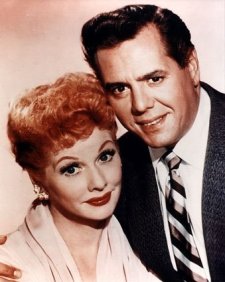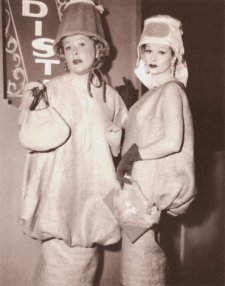Lucille Ball
had spent three seasons on CBS radio as the female lead in the situation comedy
My Favorite Husband when she decided to give the new medium, television,
a try. In her radio role as Liz Cooper, she perfected many of the mannerisms
that she would use in I Love Lucy, including the scatterbrained quality
and the loud crying fits when things weren’t going her way. CBS was enthusiastic
about the concept of the show, but the network nabobs had two major objections –
they were positive nobody would believe Desi was her husband (despite the fact
that they were married in real life), and they wanted the show done live from
New York, like most of the other early television comedies. Lucy was determined
to use Desi and had no desire to commute from Hollywood to New York for the
show. In the summer of 1950, the two of them went on tour performing before live
audiences to prove that Desi was believable as her husband, and early in 1951,
they produced a film pilot for the series with $5,000 of their own money. The
pilot convinced the CBS brass that they had something special and I Love Lucy
was given a berth on the fall schedule.
The premise
of I Love Lucy not that much different from that of other family
situation comedies on television and radio – a wacky wife making life difficult
for a loving but perpetually irritated husband – but the people involved made it
something very special. Lucy Ricardo was an American of Scottish ancestry (her
maiden name was MacGillicuddy) married to a Cuban bandleader. Husband Ricky was
employed at the Tropicana Club and since she was constantly trying to prove to
him that she could be in show business too, he spent much of his time trying to
keep Lucy off the nightclub's stage. Ricky just wanted her to be a simple
housewife. Whenever he became particularly exasperated with one of her schemes,
Ricky’s already broken English would degenerate into a stream of Spanish
epithets. The Tropicana was in Manhattan, and so was the Ricardo apartment, in a
middle-class building in the East Sixties where their neighbors, best friends,
and landlords were Fred and Ethel Mertz. Lucy’s partner in mischief was Ethel,
and both Ricky and Fred had to endure the foolishness perpetrated by their
wives.
I Love Lucy
was an immediate smash hit and during the six years in originals, never ranked
lower than third in popularity among all television programs. The plots, by
series creator and producer Jess Oppenheimer and writers Madelyn Pugh and Bob
Carroll, Jr., were superb, the gags were inventive, and Lucy’s clowning the
pièce de résistance that took I Love Lucy beyond the realm of other
contemporary comedies. As wacky as she was, audiences could empathize with and
adore her. Watching I Love Lucy in the early 1950’s became as much a part
of life as watching Milton Berle’s Texaco Star Theater had been in the late
1940’s. It was a national event when, on January 19, 1953, Lucy Ricardo gave
birth to Little Ricky on the air the same night that Lucille Ball gave birth to
her second child, Desiderio Alberto Arnaz, IV.
Over the
years, within the context of the show, Ricky became more successful. He got a
movie offer that prompted a cross-county trip by car, with the Mertzes, during
the 1954-1955 season. During the 1955-56 season, they took a trip to Europe,
also with the Mertzes, and at the start of the 1956-1957 season, Ricky opened
his own club, The Ricky Ricardo Babaloo Club. He had also gotten a TV show and,
with his good fortune, bought a country home in Connecticut early in 1957. It
was also during the 1956-1957 season that Little Ricky was added to the regular
cast. He had been played on a very occasional basis in the previous seasons by a
pair of infant twins, Joseph David Mayer and Michael Lee Mayer. Also seen on an
irregular basis over the years were Ricky's agent Jerry, the Ricardos' elderly
neighbor Mrs. Trumbull, Lucy's snooty friend Caroline Appleby, and Mrs.
MacGillicuddy, Lucy's mother.
Everyone has
certain favorite episodes of I Love Lucy, and there were so many
memorable ones that trying to cite the “best” is particularly difficult. Even
CBS executives had problems doing it. During the summer of 1958 there was a
collection of reruns titled The Top Ten Lucy Shows – there were 13
different episodes in that “top 10”. There was the show in which Lucy maneuvered
her way onto Ricky’s TV show to do a health-tonic commercial, and got drunk
sampling the high-alcohol-content product. There was the time she tried to bake
her own bread, and was pinned to the far wall in her kitchen when the loaf –
into which she had thrown two entire packages of yeast – was released from the
oven. While looking for souvenirs in Hollywood, Lucy and Ethel tried to pry
loose the block of cement with John Wayne’s footprints from in front of
Grauman’s Chinese Theatre. There was the time Lucy tried to get into Ricky’s
nightclub show by impersonating a clown. When they were going to be interviewed
on the TV show Face to Face they almost got into a fight with the Mertzes
because Ricky’s new agent wanted them to move into a classier apartment. The
messiest episode, however, had to be one that was part of their trip to Europe.
Lucy had been offered a minor role in a film by an Italian producer and, in an
effort to absorb atmosphere, ended up in a vat of un-pressed grapes fighting
with a professional grape stomper.
The success
of I Love Lucy is unparalleled in the history of television. The decision
to film it, rather than do it live, made it possible to have a high-quality
print of each episode available for endless rebroadcasts, as opposed to the
poor-quality kinescopes of live shows. The reruns, sold to independent stations
after I Love Lucy left the network, and translated into virtually every
language for foreign distribution, made millions. This set the pattern for all
of television. The appeal of reusable filmed programs all started, by I Love
Lucy, eventually resulted in the shift of television production from
New York, where it had all started, to Hollywood, where the film facilities
were. I Love Lucy was practically unique in that it was filmed before a
live audience, something that did not become widespread in the situation comedy
world until the 1970’s, and the technique of simultaneously using three cameras
during the filming to allow for editing of the finished product was also a
Lucy first.
By the end of
the 1956-1957 season, despite the fact it was still the number-one program in
all of television, I Love Lucy ceased production as a weekly series. For
the two years prior to the suspension of production, both Lucy and Desi had been
seeking to cut down on their workload. The finally succeeded. After the fall of
1957, there was no I Love Lucy, but there was a number of Lucille
Ball-Desi Arnaz Shows, full-hour specials about the continuing travels and
tribulations of the Ricardos and the Mertzes.
Reruns of
I Love Lucy had aired during the summer of 1955 as The Sunday Lucy Show
and during the 1955-1956 season on Saturdays as The Lucy Show. With the
original show out of production, prime-time reruns of I Love Lucy were
aired for another two years on CBS, showed up briefly in 1961, and ran in
daytime on CBS until 1967. The syndicated reruns have been running continuously
ever since, and there is no end in sight.

















